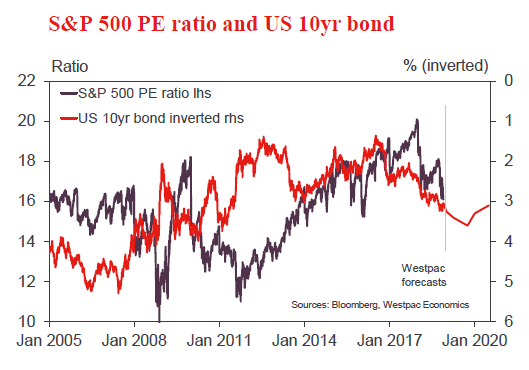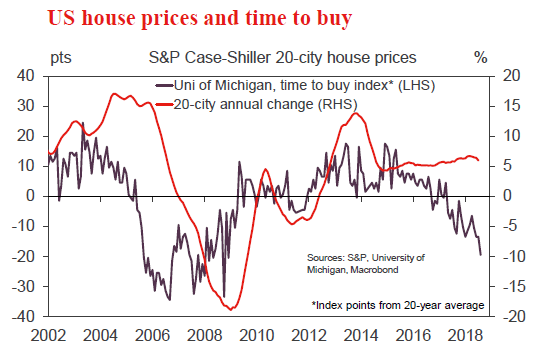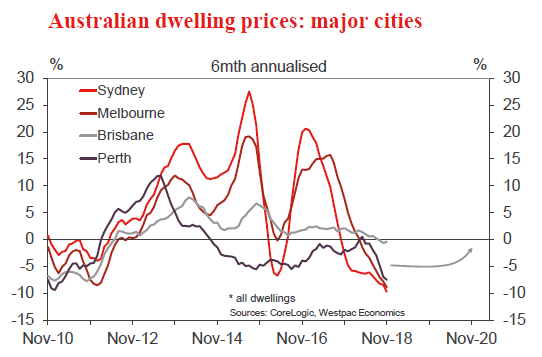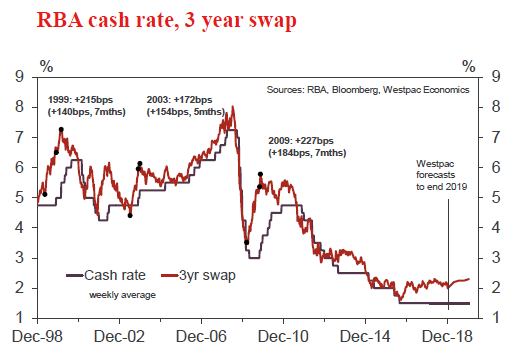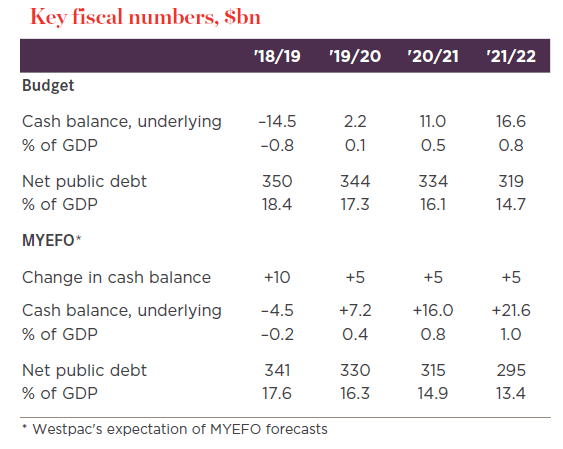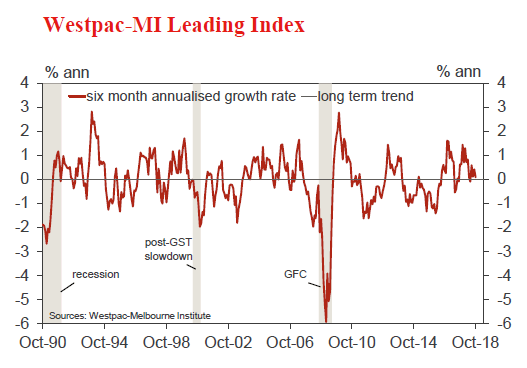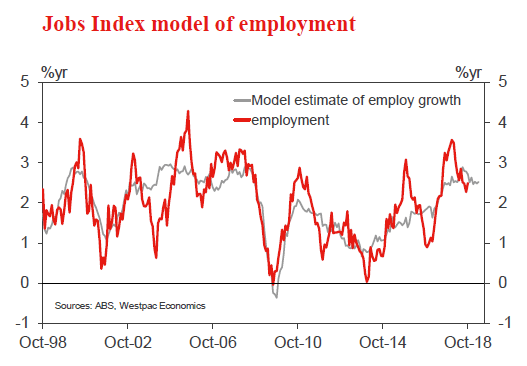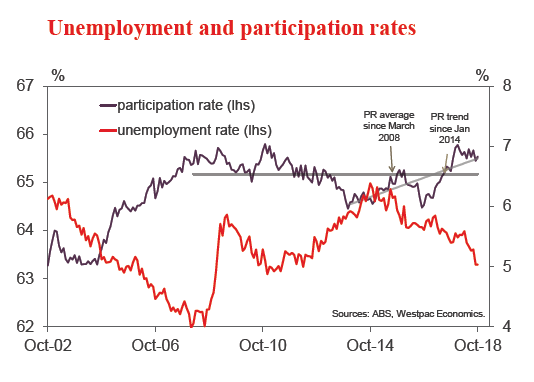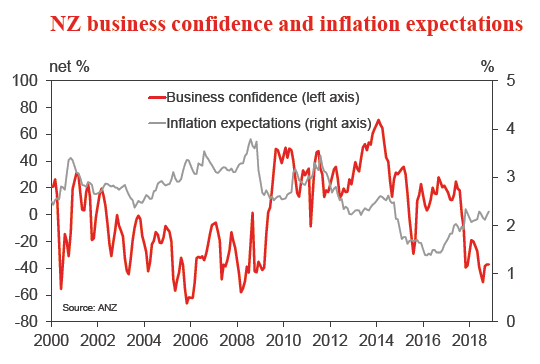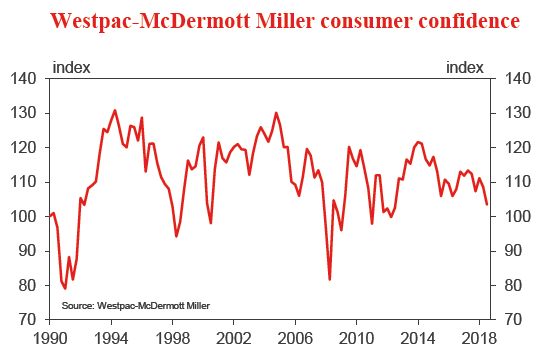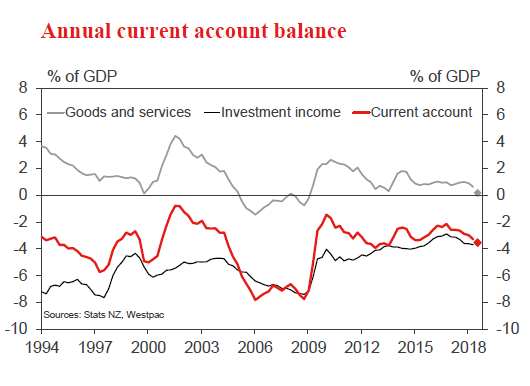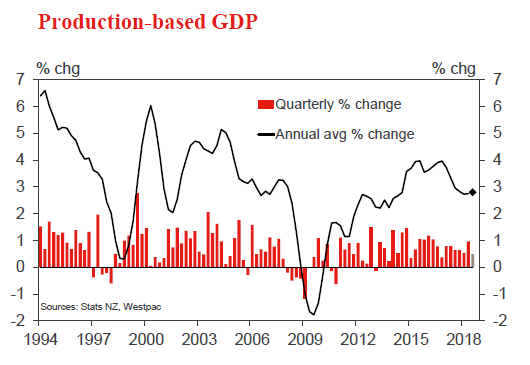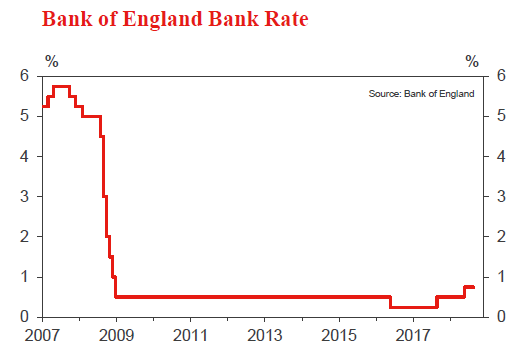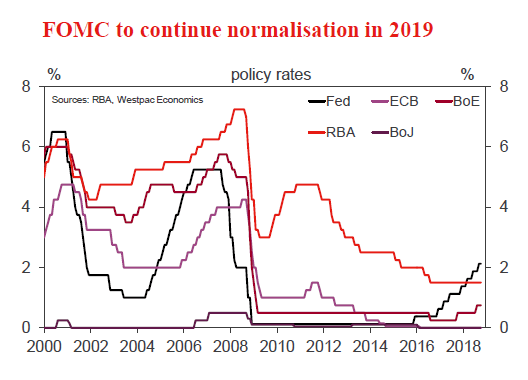Week beginning 17 December 2018
- What might our economic forecasts mean for investors?
- Australia: Federal Budget mid-year update, RBA minutes, employment, Westpac-MI Leading Index.
- NZ: GDP, Westpac-MM consumer confidence, business confidence, current account.
- Europe: consumer confidence.
- US: FOMC policy decision, GDP 3rd estimate, durable goods orders.
- Central banks: BOE policy decision, BOJ policy decision.
- Key economic & financial forecasts.
Information contained in this report current as at 14 December 2018.
What might our economic forecasts mean for investors?
What do our economic forecasts for 2019 mean for Investors?
Our key economic themes are:
Australian economy and markets
- Growth in the Australian economy will slow in 2019 under the weight of political uncertainty; falling house prices; a contraction in residential construction; global volatility; and a softening labour market.
- Australia’s commodity price Index will fall as China softens its anti-pollution policies; supply lifts; and China’s economy slows.
- Housing affordability in Sydney and Melbourne is still stretched and further adjustments to affordability are necessary. With limited scope to rely on the adjustment factors of previous downturns (interest rates and strong household income growth) residential prices are set to fall further in Sydney and Melbourne through the year .
- Credit conditions are unlikely to ease significantly representing further complications. Even if prices adjust sufficiently to stabilise affordability and attract new buyers funding difficulties will complicate the recovery. In markets where affordability is not stretched credit tightening will still weaken conditions.
- The Reserve Bank is likely to keep the cash rate on hold through the year further widening the yield differential with the US.
- Lower commodity prices; deteriorating yield differentials; wide spread scepticism around the housing market will weigh on the AUD with a target of USD 0.68 seeming reasonable.
US economy and markets
- The bond markets are underestimating the momentum in the US economy particularly around the consumer and the resulting commitment of the Federal Reserve to higher rates.
- The federal funds rate is likely to peak at 3.125% by September (four more hikes) rather than the 2.5% which is currently factored into the market implying a potential Fed pause as early as March next year.
- The momentum of the US economy and the flexibility of the Federal Reserve to pause when growth is still around 2% and employment growth has eased to 1% leads us to expect a “soft landing” for the US economy with growth settling around 2% in 2020, from 2.5% in 2019.
- With recession and an early pause for the Fed unlikely there is going to be another wave of increases in the 10 year bond rate with a likely trough to peak move from the current 2.90% to 3.4% by September quarter next year.
- There is likely to be an extension of the fiscal spending initiatives from last year well into 2020, the Presidential election year.
- This sustained growth momentum ; a more aggressive Federal Reserve; and higher bond rates will further boost the USD which is expected to lift by a further 3% through the first half of 2019.
China and markets
- Authorities will stay the course of deleveraging; antipollution, although at a slower pace; and rebalancing the economy towards services.
- Further constraints on capital outflows will be enforced as US interest rates pressure investors.
- It seems unlikely that the Chinese authorities will be prepared to make the specific changes to their industry and trade policy that would specifically satisfy the US needs.
- These would include changes to forced technology transfer, intellectual property protection, non-tariff barriers, forced joint venture investment, cyber intrusions and government industry subsidies.
Investments
It is firstly important to note that our December Westpac Melbourne Institute Consumer Sentiment survey showed that respondents are increasingly risk averse.
The proportion of respondents who nominated real estate as the wisest place for savings was 10% –the lowest proportion since the first survey in 1974. Equities were down to 6%, the lowest since 2012, and the sum of equites and real estate was a record low.
Preferences for bank deposits and “pay down debt” dominated while the “don’t know” category, printed a record high at 7%.
USD Cash
Australian investors are expected to receive a reasonable return by investing in USD cash. With the federal funds rate forecast to average 2.6% over the next 9 months an anticipated fall in the AUD/ USD from 0.72 to 0.68 by September investors would receive an annualised cash return in AUD of “around” 10%.
That would compare with around 1- 2% in AUD cash. Given the current mood of risk aversion such an option might be attractive. Of course the return is dependent on one of the key themes in our economic forecasts – a rising USD relative to the AUD.
Equities
Here the outlook is much more complex and the economic/ market environment which we forecast on balance sends a signal to be cautious until the second half of 2019.
Our best view is that equity strategies should recognise two separate phases. Currently, valuations are not stretched (as noted by Chairman Powell) as they were at the beginning of 2018 where forward PE ratios (S&P 500) averaged nearly 19.
They are now down to around 16.0 (around average over previous cycles). These valuations are based on quite solid forward earnings estimates and the risk is always that earnings estimates prove to be overly optimistic.
The markets’ expectations for bond rates are quite different to our own views. An increase in the 10 year bond rate over the first nine months of 2019 from the current 2.9% to our target 3.4% and a rising USD could weigh on equity prices.
Markets are also basing the current outlook on prospects for a sharp slowdown through end 2019 and into 2020, (signalled by the current low bond rates and flattening of the US yield curve).
Our current expectation is that growth in the US will hold around 2% through 2020. With the Federal Reserve expected to be on hold after September next year; bond rates falling, and a lower USD, earnings can be expected to hold up.
Other developed equity markets are likely to reflect the US market and, indeed, likely to underperform as US economic and earnings growth continues to exceed growth in those markets. Consider 2018 where a flat US market outperformed Europe (– 12%); Japan (–5%) and Australia (–5%).
However, once the USD and US interest rates fall in response to the “on hold” Federal Reserve we would expect the US market to lift and provide a solid boost to other markets.
Our economic forecasts envisage the US economy settling into a stable growth environment supported by a lower currency and lower bond rates.
In summary, the best alternative seems to be to restrict most exposure to the cash option until it is clear (we expect around September) that the federal funds rate has peaked.
Property
Residential property prices are already falling in Sydney and Melbourne and with limited flexibility or desire to cut rates by the RBA there is likely to be a full year in 2019 of house prices falling further particularly in Sydney and Melbourne.
Westpac’s “Time to Buy” index from its Consumer Sentiment survey has recently lifted indicating some recovery in interest from owner occupiers but, as discussed, only 10% of respondents in the survey nominate real estate as the “wisest place for savings” – the lowest proportion since 1974. Investors are clearly cautious about residential housing.
For the US the housing market is at a very different stage in the cycle. Robert Shiller, using his highly regarded Case – Shiller Index, estimates that prices have lifted by 53% in the current boom (2012 to present) exceeded only by the pre GFC (1997– 2006) boom (76%) and the post war (1942–1947) boom (60%).
The “Time to Buy” Index from the Michigan survey has turned negative, and with our profile for the Federal Reserve policy and the outlook for bond rates a significant turning point in the US housing market seems very likely.
That will provide the Federal Reserve with additional reason to pause. However, the US banking system is well capitalised and it seems highly unlikely that the economy will be impacted by the highly leveraged liquidity crunch which under-pinned the GFC.
Nevertheless, residential housing in the US seems a very unattractive prospect if we are correct about the Fed’s interest rate policies.
The week that was
“Continued confidence with increasing caution” was how ECB President Draghi described his view of the outlook this week. But it also describes the view of Australian consumers and businesses, and indeed how all are approaching the rolling malaise that is Brexit in the UK.
Beginning with the Australian consumer, our Westpac–MI Sentiment report for December highlighted confidence in the economy, with optimists continuing to outnumber pessimists. On a 1 and 5-year forward view, expectations over the economy are well above average. Arguably this view is built on the strength of the labour market, highlighted in our survey by below-average unemployment expectations. The atmospherics that surround this report were also favorable however, in particular: a growing belief that rates are on hold for the foreseeable future; and a 20% decline in petrol prices since November. At a time when house prices have declined significantly in Sydney and Melbourne, and there remains unease over real wages growth, this is quite a remarkable result for sentiment.
The effect of weak wages growth, declining house prices and cost of living pressures on households’ willingness to consume and invest is clear nonetheless. ‘Time to buy a major household item’ was below average and down on a year ago at December – as were Christmas spending plans in the November report. On housing, despite an improvement in recent months as prices have fallen, ‘time to buy a dwelling’ remains below average. More broadly on risk aversion, nearly two thirds of consumers now preference ‘safe options’ (deposits, superannuation and pay down debt), while only 10% favour housing – a low back to 1974. Pessimism over house price growth in Sydney and Melbourne is enduring.
For business, two reports were received this week. First from NAB, the November business survey reported current conditions still above average, but trending lower. A slightly below-average read for confidence in the month is indicative of businesses expecting a further easing of conditions ahead. The deterioration is being seen across the nation, but particularly in NSW and Victoria – where conditions were previously the strongest. Nonetheless, business remains favourably disposed towards robust employment growth and business investment. This implies that GDP growth should settle around trend in 2019 – as we anticipate.
Focusing in on the manufacturing sector, our Australian Chamber–Westpac Survey of Industrial Trends again reported strong conditions in Q4 2018, aided by continued strength in construction and public infrastructure spending as well as the lower Australian dollar. With reference to employment and investment, this survey corroborates the view of the NAB survey.
Moving offshore, this week Europe has captured the headlines. Responding to a further deterioration in the growth pulse during the second half of 2018, the ECB edged their growth forecasts down at their December meeting – albeit while keeping it above trend through to 2021. The Council also refined their characterization of the risks as “broadly balanced” but “moving to the downside” thanks to trade protectionism, emerging market vulnerabilities, financial market volatility and now geopolitical factors.
Regarding policy guidance, rates on hold until “at least through the summer of 2019, and in any case for as long as necessary” was retained; and there was also a commitment to continue asset purchase program reinvestment “for an extended period of time past the date when we start raising the key ECB interest rates and [again] in any case for as long as necessary”. The ECB is clearly set to remain on the sidelines for a while yet.
On political matters, uncertainty around Brexit was amplified (again) this week after the UK Parliament vote on the draft deal with Europe was pulled at the last minute and a vote of confidence was subsequently called on UK Prime Minister May’s leadership. By winning the vote, PM May secures the leadership of her party for a year and, given her clear commitment to it, locks in the Brexit process. PM May is now reportedly seeking ‘further assurances’ from European authorities in an effort to make the draft deal agreeable to UK Parliament. Based on available reports, this seems a tall order. All the while, the 29 March 2019 Brexit date creeps nearer. Market participants have largely kept the faith until now, but greater volatility seems likely come 2019 if the impasse persists.
Chart of the week: Westpac Market Outlook
Thinking forward to 2019, our December/January Market Outlook has just been released. In it, we detail our expectations for Australia; New Zealand; Asia; and the North Atlantic with respect to their economies and financial markets. Key themes for the new year include: a growing rate differential between Australia and the US; geopolitical tensions, particularly between the US and China; and, of course, market sentiment, to be buffeted by the above factors along with slower global growth.
New Zealand: week ahead & data wrap
Trundling along
Recent data suggests that the New Zealand economy is continuing to trundle along slowly but steadily, a view that should be supported by next week’s GDP figures. We expect a modest pickup in growth over the next couple of years, supported by a lift in fiscal spending that will be even larger than the Government is currently signalling.
This week the Government released its Half-Year Economic and Fiscal Update (HYEFU). At face value, the change in the outlook since the May Budget might appear to be negative – lower GDP growth and smaller operating surpluses for the next few years. But digging into the details reveals a less concerning story.
The Treasury was previously forecasting a sharp acceleration in GDP growth in the near term, an assumption that we described at the time as ‘heroic’. The updated forecasts now see growth picking up modestly to around 3% per annum – much in line with our view and with the range of market forecasts.
While the forecasts of real GDP have been revised down, the Treasury has also raised its inflation forecasts. At the May Budget, inflation was forecast to remain below 2% for several more years, despite strong domestic growth. Now the Treasury is essentially expecting the Reserve Bank to meet the 2% midpoint of its inflation target consistently over the coming years. Again, this brings the Treasury more in line with market forecasts.
Consequently, the forecasts for nominal GDP – which is what matters for the tax take – were little changed from the Budget. Indeed, the tax revenue projections were actually slightly higher than in the Budget, to reflect the fact that the tax take has been surprising to the upside in recent times.
The lower surplus forecasts were largely the result of some reallocation. The surplus in the June 2018 fiscal year was $2.2bn larger than expected, most of which was due to an unintended shortfall in spending towards the end of the year. That underspend is likely to be caught up this year, resulting in a $2bn reduction in the forecast surplus for June 2019. Lower surplus forecasts in the following two years were mostly due to a reclassification of some transport spending from capital to operational, with no impact on the funding requirement.
The bottom line of the HYEFU was that there is still plenty in the tin for more fiscal spending. The Government has overachieved on its self-imposed Fiscal Responsibility Rules: net debt is set to fall below 20% GDP sooner than expected, and forecast operational spending is well below the cap of 30% of GDP. Despite that, the Government did not signal an increase in its spending plans – the allowance for new spending in future Budgets remains at $2.4bn per year.
We doubt that the Government’s hands will stay off the piggy bank forever. The New Zealand public tends to ask for a slice of the action when it sees a large surplus. And the current Government faces the added pressure of having to satisfy the interests represented by three political parties. We suspect that the Government will announce an increase in spending plans closer to the time of the next election.
Next week sees the release of the balance of payments and GDP, rounding out the picture of how the economy performed up to the September quarter. We’re expecting a modest 0.5% rise in GDP (Thursday), following a 1% jump in the June quarter that benefited from one-offs in certain industries. Milk production was significantly above trend in the June quarter; it was only modestly above trend in the September quarter. Electricity demand fell in the September quarter, and lower hydro lake levels meant a greater reliance on higher-cost methods of generation. On the positive side, the mining sector appears to have rebounded from the shutdowns that affected the June quarter. And, as noted above, government spending fell short in the June quarter but has been catching up in recent months.
We expect the current account deficit (Wednesday) to widen from 3.3% to 3.6% of GDP, which would be the largest in five years. The trade balance has been hindered by lower dairy production and rising oil prices over the last couple of years, but these factors are starting to reverse. The current account is still on a path that we would consider to be sustainable over the longer term.
Other recent data releases suggest that the economy has continued to trundle along since September. Electronic card spending was down 0.4% in November, but this was influenced by a sharp fall in petrol prices during the month. Spending in the core retail sectors was up 0.5%, suggesting continued modest growth in consumer spending.
November house sales fell 8% in seasonally adjusted terms, unwinding most of the 13% spike in October. House prices eked out small gains across most regions. We’re expecting a more lively housing market over summer, due to the sharp fall in mortgage rate in recent months and the loosening of the Reserve Bank’s loan-to-value restrictions. However, we still expect this boost to be temporary, with other Government polices likely to temper house price gains.
Finally, we note that the Reserve Bank has released a consultation paper on bank capital requirements. Higher bank capital provides a greater buffer against losses during downturns (and provides more confidence that those losses will be borne by shareholders rather than taxpayers). The flipside is that capital is a more expensive form of funding for banks, resulting in higher interest rates for borrowers and more constrained credit growth. The Reserve Bank is proposing a substantial increase in banks’ capital from their current levels, though the final requirement will be determined next year after a consultation period.
Data Previews
Aus Federal budget, 2018/19 mid-year update, AUDbn
- Dec 17, Last: –14.5(pr), WBC f/c: –4.5
The Federal Government’s Mid-Year Economic and Fiscal Outlook (MYEFO) will see upgrades to the budget position as a stronger (nominal) economy boosts revenues.
National income has surprised to the high side, on higher commodity prices, and jobs growth has outperformed.
Nominal GDP growth for 2018/19 will be upgraded (5.0% from 3.75%). Real GDP growth for this year will be rounded down (2.75% from 3.0%) but out years are likely to remain at 3% – although the housing downturn is a downside risk.
On our figuring, the forecast budget position for this year and next is: -$4.5bn (a $10bn upgrade) and +$7.2bn (a $5bn upgrade). This factors in modest new spending, in the order of $1bn this year and $2bn in 2019/20.
Aus Nov Westpac–MI Leading Index
- Dec 19, Last: 0.08%
The six month annualised growth rate in the Westpac– Melbourne Institute Leading Index, which indicates the likely pace of economic activity relative to trend three to nine months into the future, slowed to +0.08% in October, down materially from the 0.89% averaged over the six months to April. That moderation is consistent broadly with the moderation seen in the Q3 national accounts and suggests the slowdown will extend into late 2018 and early 2019.
The Nov index looks likely to be soft again with component updates on: the ASX200 (down -2.8% vs -6.1% last month); the Westpac-MI Consumer Expectations Index (down -0.7% vs +4.7% last month); commodity prices (down -1.2% in AUD terms vs +4.4% last month); dwelling approvals (down -1.5% vs +5.5% last month).
Aus Nov Labour Force Survey – Employment ‘000
- Dec 20, Last: 32.8k, WBC f/c: 20k
- Mkt f/c: 20k, Range: 10k to 35k
The expected bounce in employment appeared in the October Labour Force Survey with a 32.8k rise. The market median was for 20k. However, just as in September, the mix was also positive with a 42.3k rise in full-time and a small 9.5k decline in part-time employment. In addition hours worked rose 0.3% following a 0.4% gain in September.
November is a slightly positive seasonal month and the original data suggests that a sound gain in November is possible. The business surveys, while moderating, are not pointing to a meaningful slowdown in employment growth.
The ABS released the preliminary re-benchmarking based on the census 2016 final Estimated Resident Population benchmarks. October employment is now +31.8k and Westpac is forecasting a 20k gain in November. Risks are balanced as the outgoing sample group has the same employment to population group as the sample average,
Aus Nov Labour Force Survey – Unemployment %
- Dec 20, Last: 5.0%, WBC f/c: 5.0%
- Mkt f/c: 5.0%, Range: 4.9% to 5.1%
The more important observation from October was the continuation of the trend improvement in unemployment. In the month. Unemployment was flat at 5.0%, but this is a good result seeing as the 0.3ppt drop in unemployment to 5.0% in September was due to a large drop in participation rather than a strong employment print. As such, there was always a risk participation would bounce in October. Participation did lift but the 0.1ppt rise to 65.6% still left it under the 65.7% print in August.
Holding participation flat at 65.6%, a 20k gain in employment is enough to hold the unemployment rate flat at 5.0%. In terms of risk, the ABS notes that in November, the sample group rolling out of the survey has a higher unemployment rate than the sample average so rolling that group out will lower the average. All else held equal, this presents downside risk to our unemployment forecast for November.
NZ Dec business confidence
- Dec 18, Last: –37.1
Business sentiment was unchanged at a low level in November.
It’s a relatively short interval between the release of the November and December surveys and there have been few economic developments in the interim.
That said, there have been recent announcements of changes made to concessions made in order for the Government to get its Employment Relations Bill over the line. With changes to employment law one factor that has likely been weighing on sentiment, this could be viewed as a positive development by businesses.
NZ Q4 Westpac McDermott Miller Consumer Confidence
- Dec 19, Last: 103.5
Consumer confidence fell sharply in September, dropping to its lowest in six years.
That fall occurred against a backdrop of rising petrol prices and a cooling in the housing market. Those developments saw households highlighting increased concerns about the outlook for their own finances and the economy more generally over the next year.
Since the time of the last survey, we’ve seen falls in interest rates and petrol prices, a resurgence in the housing market, and positive news on the labour market.
NZ Q3 current account, % of GDP
- Dec 19, Last: -3.3%, Westpac f/c: -3.6%, Mkt f/c: -3.6%
We expect the annual deficit to widen from 3.3% to 3.6% of GDP. While the quarterly balance for September should improve compared to June, it remains wider compared to the same time last year.
In seasonally adjusted terms the goods trade balance improved in the September quarter, with a strong lift in export volumes and a drop in import volumes. This was partly offset by a fall in services exports, as tourist spending reversed a sharp jump in the June quarter. We expect investment income flows to be little changed.
Lower milk production and rising oil prices have played a part in the widening of the deficit over the last couple of years, but these factors are starting to reverse their course. The current account remains on a path that we would consider to be sustainable over the longer term.
NZ Q3 GDP
- Dec 20, Last: 1.0%, Westpac f/c: 0.5%, Mkt f/c: 0.6%
The June quarter GDP result reflected some large one-off moves across several sectors that, on balance, provided a substantial boost to growth. We expect growth to drop back to a more modest 0.5% in the September quarter as some of those one-offs are unwound.
The underlying story is of an economy that continues to trundle along. Consumer spending growth has remained modest, as a boost to household incomes from government transfers has been offset by rising fuel prices and a subdued housing market.
The September quarter release will include the annual round of data revisions, which can alter the picture of how the economy has been performing in recent times.
UK Bank of England Bank Rate
- 20 Dec, Last: 0.75%, WBC f/c: 0.75%, Mkt f/c: 0.75%
The Bank of England left the Bank rate at 0.75% at its November policy meeting. And with Brexit negotiations and the UK’s economic outlook mired in uncertainty, there’s no chance of a rate hike at the December interest rate decision.
The real focus will be on the BOE’s rhetoric and its description of the risks around the outlook. In November, the BOE maintained a very modest tightening bias, noting that future increases were likely to be “at a gradual pace and to a limited extent”. However, the Bank’s assessment was contingent on a smooth Brexit transition, and they noted that this was a key risk for the outlook. Now, with Brexit in turmoil and likely flow–on impacts for confidence, the Bank is likely to emphasise the conditionality of its forecasts even more strongly. That could also be reflected in a softer bias statement.
US Dec FOMC meeting
- Dec 18–19, federal funds rate, last 2.125%, WBC 2.375%
In recent weeks, the market has materially reduced their expectations for rate hikes over the coming year. However, pricing for the December meeting itself has remained firm.
The basis for this view is sound, with the US economy in strong form, and the FOMC remaining of the view that, while there are risks, underlying momentum should remain above trend.
Given the tension between the FOMC’s 2019 view on rates and that of the market, the quarterly revision to forecasts and the tone of Chair Powell’s press conference will be assessed very carefully. While we believe that these communications are likely to acknowledge the risks and the data-dependent nature of policy, we foresee the Committee continuing to forecast multiple rate hikes through 2019. We anticipate one per quarter to 3.125% at September 2019.




